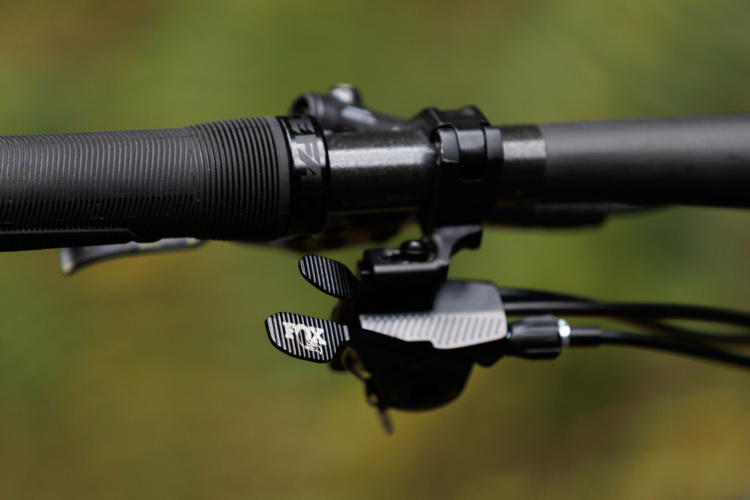
When the Pivot Switchblade was released in 2016, the model name was inspired by its ability to change between 29-inch and 27.5+ wheels and tires. Pivot updated the Switchblade last month, and although it’s likely fewer people will be putting plus-tires on the bike, it’s still as versatile as ever, and can take on mild trails, or scary drop-ins with ease. The Switchblade’s versatility has added a new dimension this time around; it is now capable of becoming a mullet bike with a 27.5″ wheel in the rear and a 29″ in the front.
The travel was upped from 135mm in the rear to 142mm, and there is now ten millimeters of additional travel up front, making for a 160mm fork. Gone again, are the swoopy tubes of the previous Switchblade, making way for top and downtubes that are straight as an arrow, keeping up with the times and its siblings, the Firebird and Mach 4 SL. Like the Mach 4 SL, the Switchblade has switched to a vertical shock layout for improved kinematics, making it more progressive, as most brands are doing with their suspension these days.
The Switchblade keeps the SuperBoost 157 rear spacing which gives the trail bike some favorable geometry. Pivot tends to be fairly conservative with geometry changes and that is reflected in the latest Switchblade. The previous generation ran for about four years, and Pivot didn’t make any huge changes to the geometry.
The head tube angle slackened to 66°, from 67.25°, and the seat angle steeped by 0.75-1.25° to 75.5° across all sizes, compared to a lot of other brands who are pushing much slacker and steeper for their head and seat tube angles. The wheelbase grew considerably across all sizes, but the rear center only gained three millimeters in length. Reach grew by over a half-inch on the medium, to 455mm, the stack height dropped, and the standover height dropped by about a half-inch on the medium also, and considerably on other sizes. Pivot has typically been pretty mindful when it comes to standover heights, in order to accommodate shorter riders. The Switchblade impressively comes in sizes XS to XL, which is nice because some brands have had trouble making longer-travel 29ers in an XS.
Pivot doesn’t really make “entry-level” builds comparable to other brands, reflecting their philosophy that the high-end frames deserve a certain level of components so that the bike can perform at its full potential. The Pro XT/XTR build I rode rings in at around $8,000 with the Reynolds carbon wheels, and the most affordable build is $5,500. Noticeably absent from the 2020 Switchblade offerings is an aluminum frame, which is a bummer since that saved buyers who weren’t interested in carbon a lot of money.

Ride impressions
I tried out the 2020 Pivot Switchblade on a couple rides during the Sedona Mountain Bike Festival, immediately following a couple of rides on the new Ibis Ripmo. Although the 142/160mm travel Switchblade is a solid mid-travel 29er, it has a really compact, low-down feel, absent of tubing that feels as wide as a 4×4 mailbox post.
Having spent a good amount of time on both the Pivot Mach 4 SL and the Firebird, the Switchblade felt absolutely like the lovechild of the two, and no one will ever need to roll the bike on to the Maury Povich stage to determine who the parents are. The Switchblade takes the climbing and descending attributes from both and offers a more well-rounded bike for the masses.
The Switchblade DW-Link suspension feels firm and snappy in its response to acceleration input. There is a minimal amount of bob when the suspension is in open mode and the bike just wants to go forward, whether it’s up or downhill. Climbing traction on the ledgy, and often loose rock around Sedona is very safe and predictable, especially with the Switchblade in open mode where it can perform as intended. The seat tube angle on the bike is not nearly as steep as others in the category and that was something I noticed about the climbing ability, when I had to really hunker down toward the cockpit on steeper hills.

With the low standover height, compact nature, and firm suspension feel of the Switchblade, it is still quite fun to ride on flatter trails. It’s full of pep and like any other Pivot I’ve ridden, the frame is stiff and responsive, so it doesn’t feel like a dead-sled on more moderate grades. I felt like I had a lot of control over the Switchblade and it was easy to translate my body and hip movement into the bike.
It is just as easy to get it moving downhill where the Switchblade remains energetic and alive, eager to pop and manual off of rollers and bumps. With a 160mm Fox 36 up front taking the brunt of the oncoming forces, the Switchblade continues to pick up speed and doesn’t hesitate heading straight into chunky trails.
How does it compare to the Ripmo?

The Ibis Ripmo and Pivot Switchblade are kind of twins, but from another mother. Both 29ers have DW-Link controlled rear suspension. The Ripmo has 147mm, and the Switchblade has 142mm of rear travel. Both have 160mm forks and are ready for EWS courses. They have a lot more in common than they do in difference, but there are some definite differences I noticed.
The Switchblade felt more like a spritely trail bike that I could race an enduro on — or win a world-level enduro if you’re Ed Masters. I felt that the Ripmo was more forgiving on the Sedona trails that I rode both on. You can be a little less picky on lines riding the Ripmo, and it had more punch to it. The Ripmo had more impressive traction, when it came to climbing and braking. Overall, the Ripmo seemed to have a little more brute strength when it came to descents.

The Ripmo also has an Ace when it comes to affordability, with the aluminum frame version, and consumers can get on a really solid mountain bike for $2,500 ( ! ) less than they can a Switchblade.
But, the Switchblade has a lot more liveliness to it, which I really appreciate. I could force its hand more than the Ripmo, and it was much happier to leave the ground and play. The Switchblade feels more versatile. I would consider both capable all-mountain bikes, but I’d be happier on all-day missions aboard the Switchblade.
If money was not an issue, and I could pick one based on my ride preferences, I would have to choose the Switchblade. The suspension felt a little more composed on the Ripmo and the bike felt more capable on rough descents, but I love how agile, responsive, and quick the Switchblade feels.
Closing thoughts

The 2020 Pivot Switchblade feels like the best of both worlds, when it comes to the climbing capability of the Mach 4 SL and the descending capability of the Firebird, with a result that’s somewhere in the middle. The Switchblade feels like an incredible an all-mountain bike, ready for anything from long days in the saddle to bike park laps and will gladly take up most of the room in a stable.





















1 Comments
Nov 30, 2020